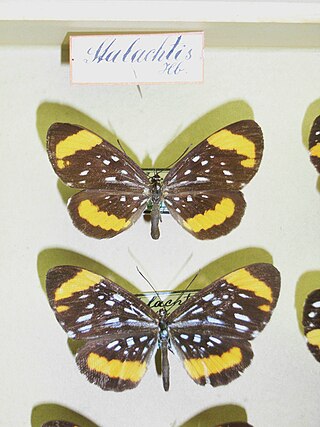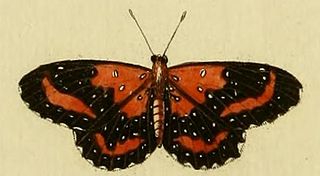
Heliconius comprises a colorful and widespread genus of brush-footed butterflies commonly known as the longwings or heliconians. This genus is distributed throughout the tropical and subtropical regions of the New World, from South America as far north as the southern United States. The larvae of these butterflies eat passion flower vines (Passifloraceae). Adults exhibit bright wing color patterns which signal their distastefulness to potential predators.

Stalachtis is a genus of metalmark butterflies. It is currently the only member of the tribe Stalachtini, but many metalmark butterflies are yet to be unequivocally assigned to tribes, so this might change eventually.

Tellervini is a tribe of danaid butterflies with only the one genus Tellervo, with six widely distributed species found in the Australasian realm and the Indomalayan realm. The taxon is apparently monophyletic, but its relationship with the other two danaid tribes is yet uncertain. The phylogeography of the group is also a challenge to those who hold to a Cenozoic origin of the butterflies.
In the 10th edition of Systema Naturae, Carl Linnaeus classified the arthropods, including insects, arachnids and crustaceans, among his class "Insecta". Butterflies and moths were brought together under the name Lepidoptera. Linnaeus divided the group into three genera – Papilio, Sphinx and Phalaena. The first two, together with the seven subdivisions of the third, are now used as the basis for nine superfamily names: Papilionoidea, Sphingoidea, Bombycoidea, Noctuoidea, Geometroidea, Tortricoidea, Pyraloidea, Tineoidea and Alucitoidea.
Phaeochlaena hazara is a moth of the family Notodontidae first described by Arthur Gardiner Butler in 1871. It is found in Brazil, Ecuador, Peru and French Guiana.

Stalachtis phlegia is a species of butterfly of the family Riodinidae. It is found in South America.

Stalachtis euterpe is a species of butterfly of the family Riodinidae. It is found in the Guianas and the Lower Amazon.

Stalachtis phaedusa is a species of butterfly of the family Riodinidae. It is found in South America.

Stalachtis calliope is a species of butterfly of the family Riodinidae. It is found in the South America.
Stalachtis magdalena is a species of butterfly of the family Riodinidae. It was described by John O. Westwood in 1851, and is known from Colombia.

Triphassa is a genus of moths of the family Pyralidae described by Jacob Hübner in 1818.





